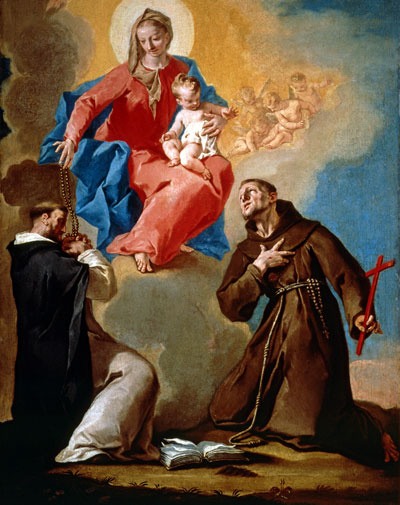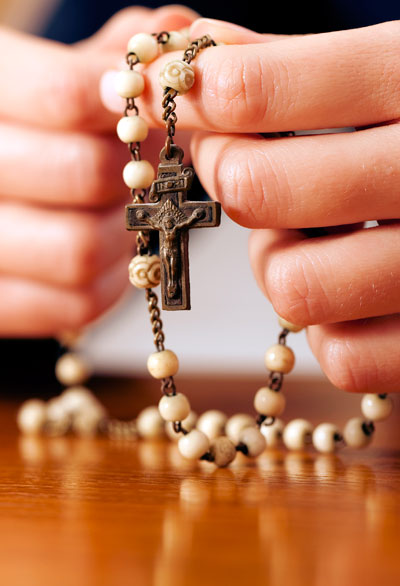Official Website of the
Catholic Diocese of Little Rock
Pray the rosary to become more like Jesus
Published: October 2, 2025
Click on the button above to find details about Pope Leo XIV's request for the faithful to join him in praying the rosary every day this month to invoke God’s gift of peace, and announces a rosary in St. Peter’s Square on Oct. 11 as part of the Jubilee of Marian Spirituality.
"By focusing our eyes on Christ, the rosary also makes us peacemakers in the world. By its nature as an insistent choral petition in harmony with Christ's invitation to 'pray ceaselessly' (Luke 18:1), the rosary allows us to hope that, even today, the difficult 'battle' for peace can be won." — St. John Paul II's apostolic letter, “Rosarium Virginis Mariae,” ("Rosary of the Virgin Mary"), Oct. 16, 2002
In addition to being Respect Life Month, October is also dedicated to the rosary primarily because the Memorial of Our Lady of the Rosary is celebrated Oct. 7. Two years after Pope St. Pius V endorsed praying the rosary, he asked the faithful to pray the rosary and seek the intercession of the Blessed Mother during the Battle of Lepanto, off the coast of Greece in 1571.
 The Blessed Mother and Jesus give the rosary to Sts. Dominic and Francis of Assisi in this 18th century painting by Nicolò Grassi. Catholic tradition holds that the Virgin Mary gave the rosary to St. Dominic in 1214.
The Blessed Mother and Jesus give the rosary to Sts. Dominic and Francis of Assisi in this 18th century painting by Nicolò Grassi. Catholic tradition holds that the Virgin Mary gave the rosary to St. Dominic in 1214.
Despite being vastly outnumbered, the Christian fleet prevailed on Oct. 7 and the Holy Father established the day as the feast of Our Lady of Victory. In 1573, Pope Gregory XIII changed the name of the feast to Our Lady of the Rosary. This event caused the devotion to gain widespread popularity that continues today.
Popes throughout the centuries have called upon the faithful to turn to the rosary in times in trouble. Pope Leo XIV continues this tradition. "I invite everyone to pray the rosary every day during the coming month for peace — personally, with your families and in your communities," he said during his weekly general audience Sept. 24.
He also asked everyone to St. Peter's Square Oct. 11 to pray the rosary together "during the vigil of the Jubilee of Marian Spirituality, also remembering the anniversary of the opening of the Second Vatican Council," which began Oct. 11, 1962.
Pope Francis invited the faithful to pray a daily rosary for peace in May 2022 to bring an end to the war and the suffering of the people of Ukraine. He made a similar request for an end to the COVID-19 pandemic in 2020. And he asked Catholics to recite the rosary "in communion and in penitence, as the people of God, in asking the holy Mother of God and St. Michael, the archangel to protect the Church from the devil, who always seeks to separate us from God and from each other" in 2018.
"To recite the rosary is nothing other than to contemplate the face of Christ with Mary," explained the late Father Raphael Kitz, OCD, in his reflection on “Rosarium Virginis Mariae." The "rosary," which in Latin means, "rose garden," is Mary’s prayer, her garden.
"The Holy Father is telling us the rosary is a journey, an adventure that changes us as we walk along the way. In other words, the devotion is a being with and becoming like our Lord Jesus Christ as we travel to our final destiny, eternal life," Father Raphael wrote.
For those unfamilar with the rosary, the U.S. bishops and many others give a good explanation of how to pray it. "The rosary is a Scripture-based prayer. It begins with the Apostles' Creed, which summarizes the great mysteries of the Catholic faith. The Our Father, which introduces each mystery, is from the Gospels. The first part of the Hail Mary is the angel's words announcing Christ's birth and Elizabeth's greeting to Mary. St. Pius V officially added the second part of the Hail Mary. The mysteries of the rosary center on the events of Christ's life. There are four sets of mysteries: Joyful, Sorrowful, Glorious, and — added by St. John Paul II in 2002 — the Luminous."
Steps to Praying the Rosary
The following directions were provided by the U.S. bishops, but there are many others that offer good directions such as the Vatican, Word on Fire, Hallow, Dynamic Catholic and FORMED.
 Make the Sign of the Cross.
Make the Sign of the Cross.- Holding the crucifix, say the Apostles' Creed.
- On the first bead, say an Our Father.
- Say one Hail Mary on each of the next three beads.
- Say the Glory Be
- For each of the five decades, announce the mystery (perhaps followed by a brief reading from Scripture) then say the Our Father.
- While fingering each of the 10 beads of the decade, next say 10 Hail Marys while meditating on the mystery. Then say a Glory Be.
- After finishing each decade, many say the Fátima Prayer: "O my Jesus, forgive us our sins, save us from the fires of hell; lead all souls to heaven, especially those who have most need of your mercy."
- After saying the five decades, say the Hail, Holy Queen, followed by this dialogue and prayer:
V. "Pray for us, O holy Mother of God."
R. "That we may be made worthy of the promises of Christ."
Let us pray: "O God, whose only begotten Son, by his life, death, and resurrection, has purchased for us the rewards of eternal life, grant, we beseech thee, that while meditating on these mysteries of the most holy rosary of the Blessed Virgin Mary, we may imitate what they contain and obtain what they promise, through the same Christ our Lord. Amen."




